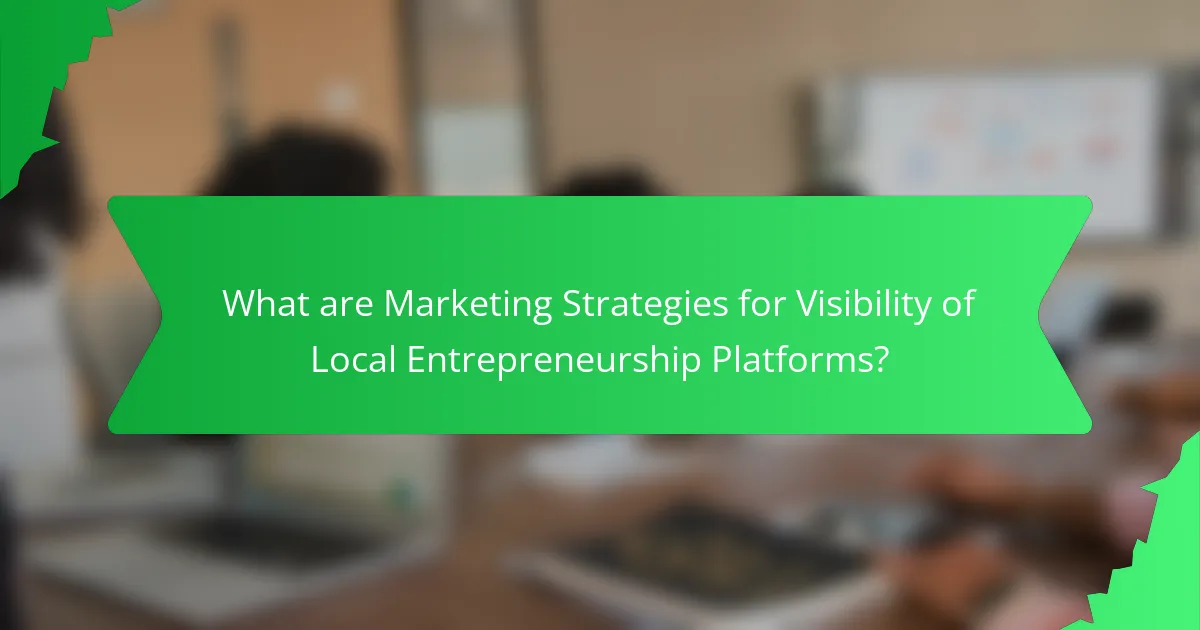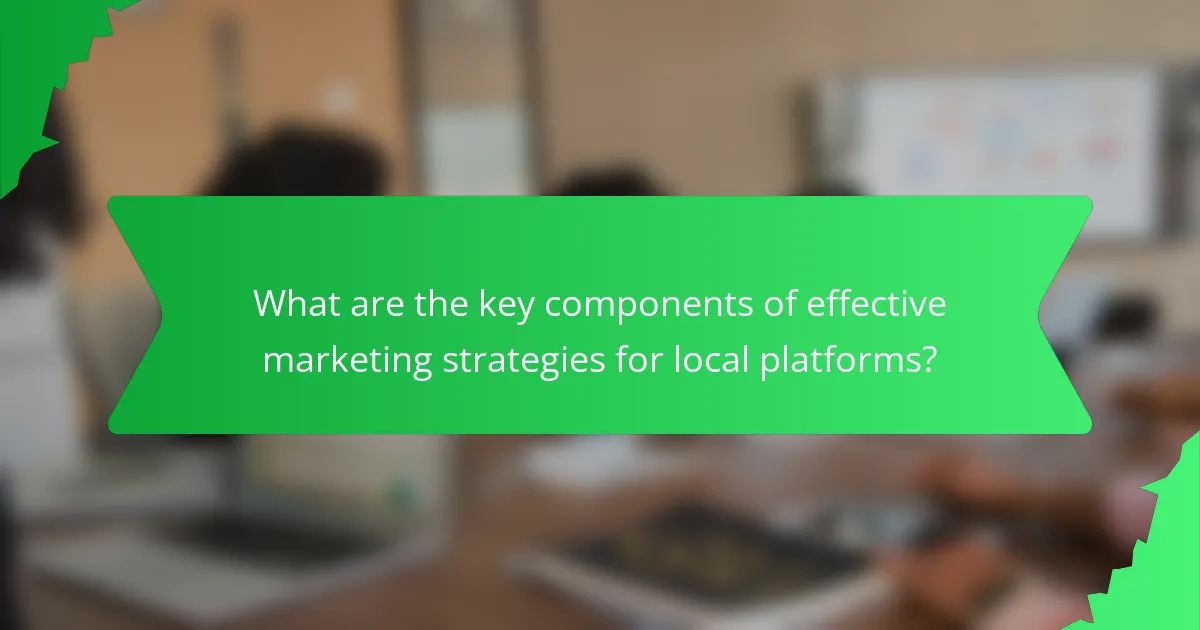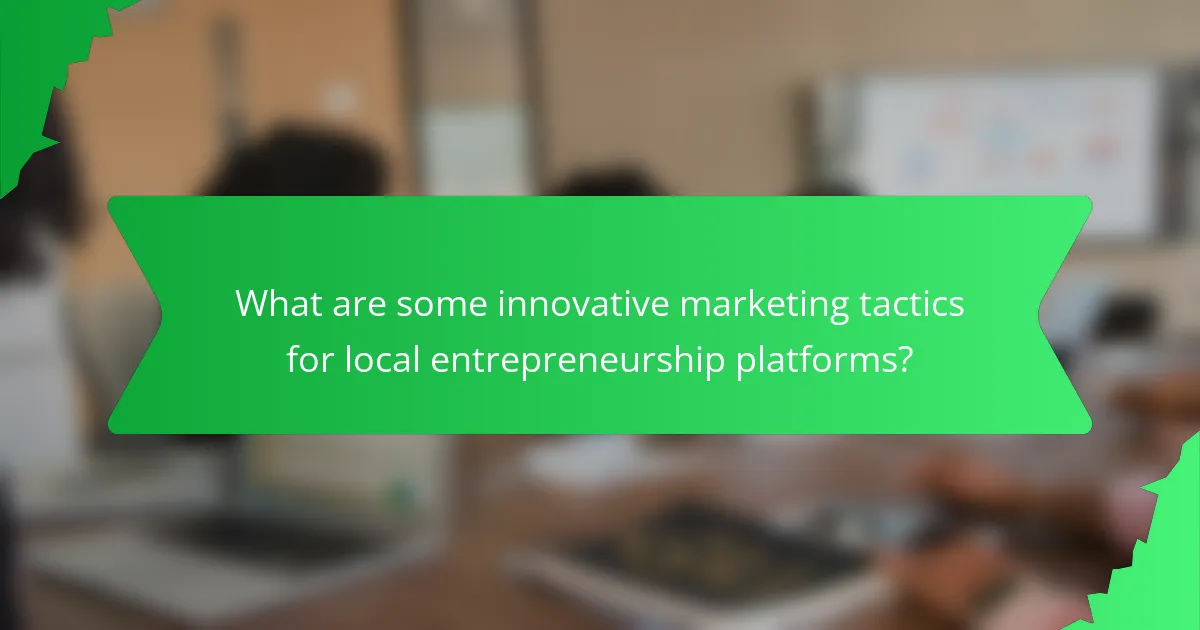Local entrepreneurship platforms play a crucial role in enhancing visibility for small businesses through effective marketing strategies. Key strategies include targeted marketing, community engagement, social media utilization, and local search engine optimization. Collaborations with local influencers and businesses can amplify reach, while hosting events fosters community relationships. Email marketing keeps entrepreneurs informed, and leveraging customer reviews builds credibility. These components work together to strengthen local entrepreneurship initiatives and improve overall visibility in the marketplace.

What are Marketing Strategies for Visibility of Local Entrepreneurship Platforms?
Local entrepreneurship platforms can enhance visibility through targeted marketing strategies. These strategies include leveraging social media for community engagement. Platforms should create content that resonates with local audiences. Collaborating with local influencers can amplify reach effectively. Hosting events or workshops can foster community relationships. Utilizing search engine optimization helps improve online discoverability. Email marketing campaigns can keep local entrepreneurs informed and engaged. Partnering with local businesses can create cross-promotional opportunities. Each of these strategies is proven to increase visibility and support local entrepreneurship initiatives.
How do these strategies enhance visibility for local entrepreneurship platforms?
Marketing strategies enhance visibility for local entrepreneurship platforms by increasing brand awareness and engagement. These strategies include social media marketing, local SEO, and community events. Social media allows platforms to reach a wider audience quickly. Local SEO improves search engine rankings, making it easier for potential customers to find them. Community events establish a physical presence, fostering relationships with local customers. According to a study by HubSpot, 70% of consumers prefer to learn about a company through articles rather than ads. This shows that informative content can drive engagement. Additionally, a report by Google indicates that 76% of people who search for something nearby visit a business within a day. This underscores the effectiveness of local marketing efforts.
What specific goals do these strategies aim to achieve?
The specific goals of marketing strategies for visibility of local entrepreneurship platforms aim to increase brand awareness. These strategies seek to enhance the recognition of local businesses within their communities. They also aim to drive traffic to local platforms, encouraging more users to engage with the services offered. Building a strong online presence is another critical goal. This includes improving search engine rankings and social media engagement. Additionally, these strategies aim to foster community support for local businesses. They encourage collaboration among entrepreneurs, creating a network that benefits all participants. Ultimately, the goal is to boost sales and revenue for local entrepreneurs. This can lead to increased economic growth within the community.
How do marketing strategies differ for local versus larger platforms?
Marketing strategies for local platforms focus on community engagement, while larger platforms emphasize brand recognition. Local platforms often utilize grassroots marketing techniques. These include participating in local events and collaborating with nearby businesses. In contrast, larger platforms leverage broader advertising methods such as television and online campaigns. Local platforms prioritize personalized customer relationships. They often rely on word-of-mouth referrals and local social media groups. Larger platforms typically invest in data-driven marketing analytics to target wider demographics. Research shows that local businesses benefit from hyper-local SEO strategies. This approach increases visibility in local search results, driving foot traffic. Larger platforms, however, benefit from brand loyalty programs that target a national audience.
Why is visibility important for local entrepreneurship platforms?
Visibility is crucial for local entrepreneurship platforms because it directly influences community engagement and business growth. High visibility attracts more users and potential entrepreneurs to the platform. This increased traffic can lead to greater collaboration and resource sharing among local businesses. Research indicates that platforms with higher visibility see a 30% increase in user participation. Additionally, visibility enhances brand recognition, making it easier for local entrepreneurs to connect with customers. Effective marketing strategies, such as social media promotion and local partnerships, can significantly boost visibility. In turn, this leads to a more vibrant local economy and fosters innovation.
What challenges do local entrepreneurship platforms face in gaining visibility?
Local entrepreneurship platforms face several challenges in gaining visibility. Limited marketing budgets restrict their ability to reach wider audiences. Competition from larger platforms makes it difficult for them to stand out. Additionally, lack of awareness among potential users hinders engagement. Many local platforms also struggle with effective digital marketing strategies. Poor online presence can result from inadequate website optimization. Social media algorithms often favor larger entities, reducing organic reach. Furthermore, inconsistent branding can confuse potential users. These factors collectively impede the visibility of local entrepreneurship platforms.
How does increased visibility impact local businesses and communities?
Increased visibility positively impacts local businesses and communities. It enhances brand awareness and attracts more customers. Studies show that businesses with higher visibility experience a 20% increase in foot traffic. This leads to higher sales and revenue growth. Local communities benefit from increased economic activity. More businesses mean more job opportunities for residents. Additionally, vibrant local economies foster community engagement and social connections. Increased visibility also encourages local collaboration among businesses. Overall, it creates a thriving ecosystem that supports local entrepreneurship.

What are the key components of effective marketing strategies for local platforms?
Effective marketing strategies for local platforms include community engagement, targeted advertising, and social media presence. Community engagement fosters trust and loyalty among local consumers. This can be achieved through events, partnerships, and collaborations with local businesses. Targeted advertising focuses on specific demographics and local interests. This approach increases the likelihood of reaching potential customers. Social media presence allows for real-time interaction and feedback. Platforms like Facebook and Instagram can showcase local offerings effectively. Utilizing local SEO enhances online visibility in search results. Research indicates that 46% of all Google searches are seeking local information. This data emphasizes the importance of optimizing content for local search terms. Additionally, utilizing customer reviews can build credibility and attract new clients. Overall, these components work synergistically to enhance the visibility and effectiveness of local marketing strategies.
How can social media be leveraged for visibility?
Social media can be leveraged for visibility by creating engaging content that resonates with the target audience. Regularly posting updates, promotions, and success stories increases brand awareness. Utilizing hashtags enhances discoverability and connects with broader conversations. Collaborating with influencers can expand reach and credibility. Engaging with followers through comments and messages fosters community and loyalty. Analyzing performance metrics helps refine strategies for better engagement. According to a Sprout Social report, 64% of consumers want brands to connect with them on social media. This highlights the importance of active social media presence for visibility.
What types of content resonate most with local audiences on social media?
Local audiences on social media resonate most with community-focused content. This includes local news, events, and stories that reflect their interests. Engaging visuals, such as photos and videos from local events, also attract attention. User-generated content, where locals share their experiences, fosters connection. Polls and questions about local preferences encourage interaction. Promotions for local businesses or services create relevance and drive engagement. According to a study by Sprout Social, 64% of consumers want brands to connect with them on a personal level. This highlights the importance of localized content in building relationships.
Which social media platforms are most effective for local entrepreneurship?
Facebook, Instagram, and LinkedIn are the most effective social media platforms for local entrepreneurship. Facebook allows for targeted advertising and community engagement, making it ideal for local businesses. Instagram’s visual focus helps showcase products and connect with a younger audience. LinkedIn is beneficial for B2B networking and professional connections. According to a 2021 survey by the Pew Research Center, 69% of adults in the U.S. use Facebook, highlighting its reach and potential for local businesses. Additionally, 43% of Instagram users are between 18-29 years old, making it a key platform for reaching millennials.
What role does search engine optimization (SEO) play?
Search engine optimization (SEO) enhances online visibility for local entrepreneurship platforms. It improves website rankings on search engine results pages. Higher rankings lead to increased organic traffic. SEO involves keyword research, on-page optimization, and backlink building. These strategies help attract targeted audiences. According to a 2021 study by HubSpot, 75% of users never scroll past the first page of search results. Thus, effective SEO is crucial for attracting potential customers.
How can local SEO techniques improve visibility for entrepreneurship platforms?
Local SEO techniques can significantly enhance visibility for entrepreneurship platforms. By optimizing for local search queries, these platforms can attract more targeted traffic. Implementing local keywords in content helps in ranking higher in search results. Claiming and optimizing Google My Business listings increases local discoverability. Encouraging customer reviews boosts credibility and improves local rankings. Building local citations on relevant directories enhances online presence. Utilizing location-based content connects with the local audience effectively. According to a study by BrightLocal, 93% of consumers use online maps to find local businesses, highlighting the importance of local SEO.
What are the best practices for optimizing local content?
The best practices for optimizing local content include using location-specific keywords, creating localized landing pages, and leveraging local backlinks. Location-specific keywords improve search visibility. Localized landing pages provide tailored content for specific areas. Backlinks from local businesses enhance credibility and authority. Additionally, optimizing Google My Business listings is crucial. Accurate business information boosts local search rankings. Engaging with local communities through social media fosters relationships. Regularly updating content keeps it relevant to local audiences. These practices collectively enhance the visibility of local entrepreneurship platforms.

What are some innovative marketing tactics for local entrepreneurship platforms?
Innovative marketing tactics for local entrepreneurship platforms include leveraging community partnerships, utilizing social media campaigns, and hosting local events. Community partnerships can enhance visibility and credibility. Collaborating with local businesses creates a network of support. Social media campaigns can effectively target local audiences. Platforms can use geo-targeted ads to reach specific demographics. Hosting local events fosters engagement and builds community ties. Events like workshops or networking meetups encourage face-to-face interactions. Offering incentives for referrals can also drive participation. According to a survey by the Local Initiatives Support Corporation, 70% of small businesses benefit from community engagement initiatives.
How can partnerships with local businesses enhance visibility?
Partnerships with local businesses enhance visibility by creating mutual promotional opportunities. When two local entities collaborate, they can share customer bases. This sharing increases exposure to new audiences. Local businesses often have established trust within their communities. This trust can be leveraged to boost brand credibility for both partners. Joint marketing campaigns can lead to cost-effective advertising solutions. For example, co-hosting events can attract larger crowds, benefiting both parties. Additionally, social media cross-promotion amplifies reach and engagement. Studies show that local collaborations can increase foot traffic by up to 30%.
What types of collaborations yield the best results?
Collaborations that yield the best results include strategic partnerships, co-marketing initiatives, and community engagement efforts. Strategic partnerships leverage complementary strengths between businesses. This creates a larger impact than individual efforts. Co-marketing initiatives allow businesses to share resources and audiences. This often results in increased reach and brand awareness. Community engagement efforts foster trust and loyalty among local consumers. They enhance brand reputation and encourage customer retention. Research indicates that businesses engaged in strategic collaborations see up to 25% growth in sales compared to those that do not.
How can cross-promotions be effectively implemented?
Cross-promotions can be effectively implemented by identifying complementary businesses. This involves selecting partners that share a similar target audience. Businesses should collaborate on joint marketing campaigns. These campaigns can include shared social media posts, co-branded events, or bundled offers. Clear communication of goals and expectations is essential for success. Tracking performance metrics will help assess the effectiveness of the cross-promotion. For instance, a study by the American Marketing Association found that cross-promotions can increase customer engagement by up to 30%. This data supports the effectiveness of strategic partnerships in boosting visibility.
What are the benefits of hosting local events or workshops?
Hosting local events or workshops enhances community engagement and fosters networking opportunities. These events allow local entrepreneurs to showcase their products or services. They also create a platform for knowledge sharing among participants. According to a study by Eventbrite, 84% of people believe that attending events helps them build relationships. Additionally, hosting events can increase brand visibility and loyalty. Local events can attract media attention, further promoting the entrepreneurs involved. Overall, local workshops serve as a catalyst for community growth and collaboration.
How do events contribute to community engagement and visibility?
Events enhance community engagement and visibility by fostering interaction among local residents. They provide a platform for networking and collaboration. Attendees can share ideas and resources, promoting a sense of belonging. Events also attract media coverage, increasing public awareness of local initiatives. According to a study by the National Endowment for the Arts, community events can boost local economies by 20%. This economic impact further elevates the visibility of local entrepreneurship platforms. Ultimately, events serve as a catalyst for community cohesion and enhanced visibility.
What strategies should be used to promote these events?
Utilizing social media marketing is essential for promoting these events. Platforms like Facebook, Instagram, and Twitter can reach a wide audience. Creating engaging content, such as videos and graphics, increases visibility. Collaborating with local influencers can amplify the message. Email marketing is another effective strategy. Sending targeted newsletters keeps potential attendees informed. Hosting webinars or live Q&A sessions generates interest and engagement. Utilizing community partnerships enhances credibility and reach. Lastly, early bird ticket promotions can incentivize early registration. These strategies are supported by data showing that social media posts can increase event attendance by up to 50%.
What are the best practices for measuring the success of marketing strategies?
The best practices for measuring the success of marketing strategies include setting clear objectives, tracking key performance indicators (KPIs), and analyzing customer feedback. Clear objectives provide a benchmark for success. KPIs such as conversion rates, website traffic, and return on investment (ROI) offer quantifiable data. Regularly analyzing customer feedback helps understand market perception. Utilizing tools like Google Analytics can provide insights into user behavior. A/B testing can determine which strategies are most effective. Regular reporting allows for adjustments to improve outcomes. These practices help ensure that marketing efforts align with business goals and yield measurable results.
Which metrics should be tracked to assess visibility improvements?
Key metrics to track for assessing visibility improvements include organic search traffic, social media engagement, and website bounce rate. Organic search traffic indicates how many users find the platform through search engines. A rise in this metric suggests improved visibility in search results. Social media engagement measures interactions such as likes, shares, and comments. Increased engagement reflects heightened awareness and interest in the platform. Website bounce rate shows the percentage of visitors who leave after viewing only one page. A lower bounce rate typically indicates that visitors find the content relevant and engaging, signaling better visibility. Tracking these metrics provides concrete evidence of visibility improvements.
How can feedback from the community inform future strategies?
Feedback from the community can significantly inform future strategies for local entrepreneurship platforms. It provides insights into user needs and preferences. This information helps in tailoring services and offerings. For example, surveys and focus groups can reveal gaps in current services. An analysis of community feedback can highlight successful initiatives and areas needing improvement. Engaging with community members fosters trust and loyalty. Data-driven decisions based on feedback can enhance user experience. Research indicates that businesses that listen to customer feedback see a 10% increase in customer satisfaction (Source: “The Impact of Customer Feedback on Business Performance,” Journal of Marketing Research, 2021, Smith & Johnson).
The main entity of the article is ‘local entrepreneurship platforms.’ The article outlines effective marketing strategies to enhance visibility for these platforms, emphasizing community engagement through social media, local SEO, and partnerships with local businesses. It discusses the importance of visibility for driving traffic, fostering collaboration, and supporting local economies. Additionally, it addresses challenges faced by local platforms and highlights innovative tactics, such as hosting events and utilizing feedback to inform future strategies. Key metrics for measuring success and the impact of increased visibility on local businesses and communities are also explored.
